Gunship
A gunship is a military aircraft armed with heavy guns, primarily intended for attacking ground targets.
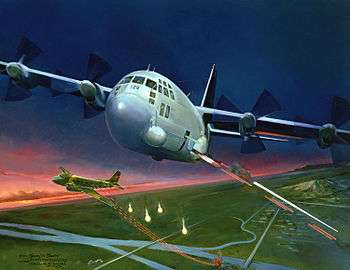
In modern usage the term "gunship" refers to fixed-wing aircraft having laterally-mounted heavy armaments (i.e. firing to the side) to attack ground or sea targets.[1][2] These gunships were configured to circle the target instead of performing strafing runs. Such aircraft have their armament on one side harmonized to fire at the apex of an imaginary cone formed by the aircraft and the ground when performing a pylon turn (banking turn).[1][2]
The term helicopter gunship is commonly used to describe armed helicopters.
Terminology
The term "gunship" originated in the mid-19th century as a synonym for gunboat and also referred to the heavily armed ironclad steamships used during the American Civil War.[3]
World War II aviation
Bomber escort
During 1942 and 1943, the lack of a usable escort fighter for the United States Army Air Forces in the European Theatre of Operations led to experiments in dramatically increasing the armament of a standard Boeing B-17F Flying Fortress, and later a single Consolidated B-24D Liberator to each have 14 to 16 Browning AN/M2 .50 cal machine guns as the Boeing YB-40 Flying Fortress and Consolidated XB-41 Liberator respectively; each meant to accompany regular heavy bomber formations over occupied Europe on strategic bombing raids for long-range escort duties as "flying destroyer gunship"s[4] The YB-40 was sometimes described as a gunship,[5] and a small 25-aircraft batch of the B-17-derived gunships were built, with a dozen of these deployed to Europe; the XB-41 had problems with stability and did not progress.
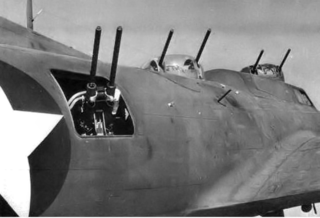 The increased machine gun armament of a Boeing YB-40 Flying Fortress, leading it to be dubbed a gunship in 1942-43
The increased machine gun armament of a Boeing YB-40 Flying Fortress, leading it to be dubbed a gunship in 1942-43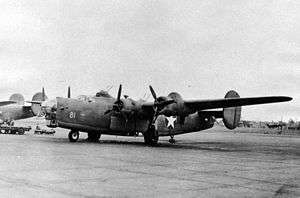 Heavily armed Consolidated XB-41 Liberator gunship prototype. Note the chin and twin dorsal turrets.
Heavily armed Consolidated XB-41 Liberator gunship prototype. Note the chin and twin dorsal turrets.
Attack aircraft
During World War II, the urgent need for hard-hitting attack aircraft led to the development of the heavily armed gunship versions of the North American B-25 Mitchell. For use against shipping in the Pacific 405 B-25G were armed with a 75 mm (2.95 in) M4 cannon and a thousand B-25H followed. The H models, delivered from August 1943, moved the dorsal turret forward to just behind the cockpit and were armed with the lighter 75mm T13E1 cannon.[6] The B-25J variant, removed the 75mm guns but carried a total of eighteen 0.50 cal (12.7 mm) AN/M2 Browning machine guns, more than any other contemporary American aircraft: eight in the nose, four in under-cockpit conformal flank-mount gun pod packages, two in the dorsal turret, one each in the pair of waist positions, and a pair in the tail;[6]; giving a maximum of fourteen guns firing forward in strafing runs.[7] Later the B-25J was armed with eight 5 in. (130 mm) high velocity aircraft rockets (HVAR).[6][8]
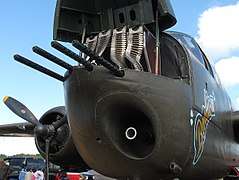 B-25H Gunship Barbie III showing 75mm M5 gun and 4 .50 Browning machine guns and ammunition.
B-25H Gunship Barbie III showing 75mm M5 gun and 4 .50 Browning machine guns and ammunition.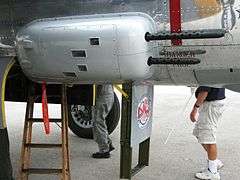 Closeup of an early model B-25 gun pod.
Closeup of an early model B-25 gun pod.- B-25J "Sunday Punch" showing 8 nose-mounted .50 Browning machine guns and 2 more on gun pods.
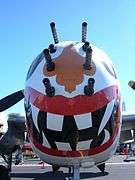 Close-up of B-25J "Sunday Punch" showing 8 nose-mounted .50 Browning machine guns.
Close-up of B-25J "Sunday Punch" showing 8 nose-mounted .50 Browning machine guns.
The British also made large numbers of twin-engined fighter bombers. The de Havilland Mosquito FB.VI had a fixed armament of four 20 mm Hispano Mk.II cannon and four .303 (7.7 mm) Browning machine guns. Together with up to 4,000 pounds of bombs in the bomb bay and on racks housed in streamlined fairings under each wing, or up to eight "60lb" RP-3 rockets. de Havilland also produced seventeen Mosquito FB Mk XVIII armed with a 57 mm QF 6-pdr anti-tank gun with autoloader which were used against German ships and U-boats.
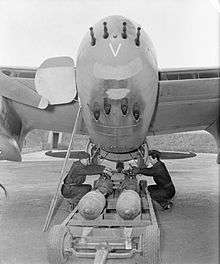 Mosquito four 20 mm cannon and four .303 in machine guns and four 500 lb bombs.
Mosquito four 20 mm cannon and four .303 in machine guns and four 500 lb bombs.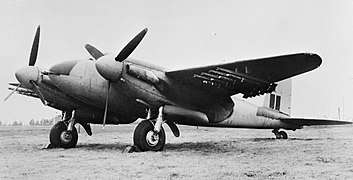 RAF Coastal Command Mosquito armed with eight RP-3 rockets on wings.
RAF Coastal Command Mosquito armed with eight RP-3 rockets on wings.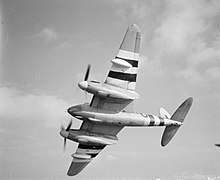 Mosquito showing the 57 mm "Molins gun" and streamlined blister used to accommodate the automatic loading mechanism
Mosquito showing the 57 mm "Molins gun" and streamlined blister used to accommodate the automatic loading mechanism
The Germans also made a sizable number of heavy fighter types (Zerstörer - "destroyer") armed with heavy guns (Bordkanone). Dedicated "tankbuster" aircraft such as the Ju 87Gs (Kanonenvogel) were armed with two BK 37mm auto-cannon in underwing gun pods. The Ju 88P gunships were armed with 37mm, 50mm and 75mm guns, and were used as tankbusters and as bomber destroyers. The Me 410 Hornisse were armed with the same BK 50mm auto-cannon as the Ju 88P-4, but were only used as bomber destroyers. None of the German twin-engine heavy fighters types were produced or converted in large numbers.
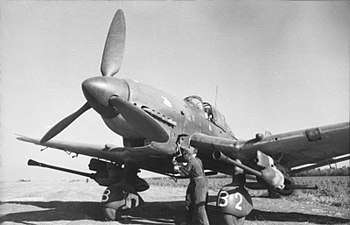 Ju 87Gs Kanonenvogel with twin 37mm autocannon in underwing gun pods
Ju 87Gs Kanonenvogel with twin 37mm autocannon in underwing gun pods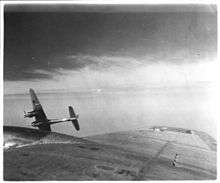 A Messerschmitt Me 410 with a 50mm BK 5 heavy autocannon peels off from attacking a 388th Bomb Group B-17 over Europe during the USAAF campaign against Germany, 1943
A Messerschmitt Me 410 with a 50mm BK 5 heavy autocannon peels off from attacking a 388th Bomb Group B-17 over Europe during the USAAF campaign against Germany, 1943
Post-World War II aviation
Fixed-wing aircraft
In the more modern, post-World War II fixed-wing aircraft category, a gunship is an aircraft having laterally-mounted heavy armaments (i.e. firing to the side) to attack ground or sea targets.[1][2] These gunships were configured to circle the target instead of performing strafing runs. Such aircraft have their armament on one side harmonized to fire at the apex of an imaginary cone formed by the aircraft and the ground when performing a pylon turn (banking turn).[1][2]
The Douglas AC-47 Spooky was the first notable modern gunship. In 1964, during the Vietnam War,[1] the popular Douglas C-47 Skytrain transport was successfully modified into a gunship by the United States Air Force with three side-firing Miniguns for circling attacks. At the time the aircraft was known as a "Dragonship", "Puff, the Magic Dragon" or "Spooky" (officially designated FC-47, later corrected to AC-47). Its three 7.62 mm miniguns could selectively fire either 50 or 100 rounds per second.[9] Cruising in an overhead left-hand orbit at 120 knots air speed at an altitude of 3,000 feet (910 m), the gunship could put a bullet or glowing red tracer (every fifth round) into every square yard of a football field-sized target in potentially less than 10 seconds.[10] And, as long as its 45-flare and 24,000-round basic load of ammunition held out, it could do this intermittently while loitering over the target for hours.
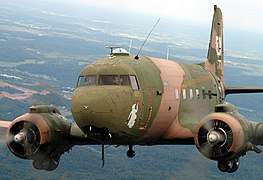 AC-47 note the Miniguns on the left side of the gunship
AC-47 note the Miniguns on the left side of the gunship.jpg) Douglas AC-47D
Douglas AC-47D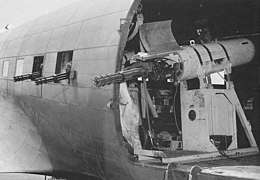 Douglas AC-47 Spooky with SUU-11/A pods, one minigun points out the cargo door, and one each points out of the two windows forward of the door.
Douglas AC-47 Spooky with SUU-11/A pods, one minigun points out the cargo door, and one each points out of the two windows forward of the door.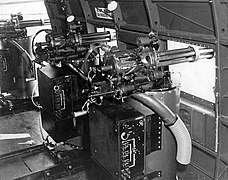 MXU-470/A minigun modules in an AC-47
MXU-470/A minigun modules in an AC-47- Night attack of a U.S. Air Force Douglas AC-47D Spooky gunship over Saigon in 1968. This time lapse photo shows the tracer round trajectories.
The lesser known Fairchild AC-119G Shadow were twin-engine piston-powered gunships developed by the United States during the Vietnam War. Armed with four 7.62 mm GAU-2/A Miniguns and two 20 mm (0.787 in) M61 Vulcan six-barrel rotary cannons, they replaced the Douglas AC-47 Spooky and operated alongside the early versions of the AC-130 Spectre gunship.
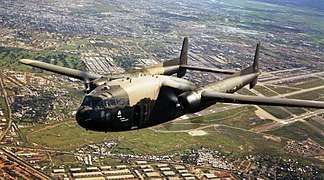 AC-119G
AC-119G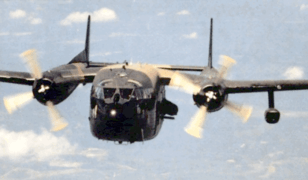 AC-119 note the guns on the left of the fuselage
AC-119 note the guns on the left of the fuselage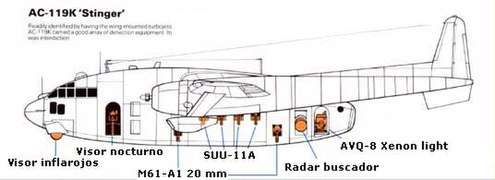 Drawing showing AC-119 guns and sensors
Drawing showing AC-119 guns and sensors
It was the later and larger Lockheed AC-130 Gunship II that became the modern, post–World War II origin of the term gunship in military aviation.[11] These heavily armed aircraft used a variety of weapon systems, including 7.62 mm GAU-2/A Miniguns, 20 mm (0.787 in) M61 Vulcan six-barrel rotary cannons, 25 mm (0.984 in) GAU-12/U Equalizer five-barreled rotary cannons, 30 mm Mk44 Bushmaster II chain guns, 40 mm (1.58 in) L/60 Bofors autocannons, and 105 mm (4.13 in) M102 howitzers. The Douglas AC-47 Spooky, the Fairchild AC-119,[12] and the AC-130 Spectre/Spooky,[13] were vulnerable, and meant to operate only after achieving air superiority.[1]
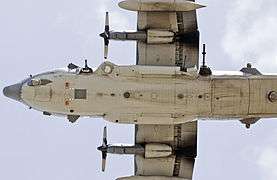 Underside of a USAF AC-130U; note the 25mm, 40mm and 105mm guns; and sensors.
Underside of a USAF AC-130U; note the 25mm, 40mm and 105mm guns; and sensors.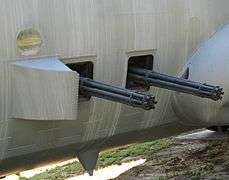 Closeup of a USAF AC-130 gunship's twin 20mm Vulcans.
Closeup of a USAF AC-130 gunship's twin 20mm Vulcans..jpg) Closeup of a USAF AC-130 gunship's 40mm Bofors and 105mm Howitzer
Closeup of a USAF AC-130 gunship's 40mm Bofors and 105mm Howitzer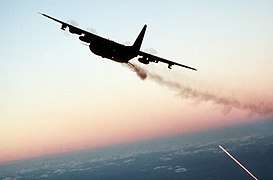 A USAF AC-130 gunship fires one of its weapons during twilight operations in 1988.
A USAF AC-130 gunship fires one of its weapons during twilight operations in 1988.
Smaller gunship designs such as the Fairchild AU-23 Peacemaker and the Helio AU-24 Stallion were also designed by the United States during the Vietnam War. These aircraft were meant to be cheap and easy to fly and maintain, and were to be given to friendly governments in Southeast Asia to assist with counter-insurgency operations, eventually seeing service with the Khmer National Air Force, Royal Thai Air Force, and Republic of Vietnam Air Force as well as limited use by the United States Air Force.
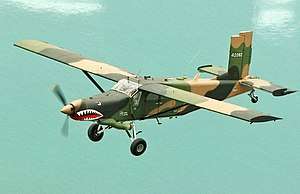 Fairchild AU-23 Peacemaker in flight
Fairchild AU-23 Peacemaker in flight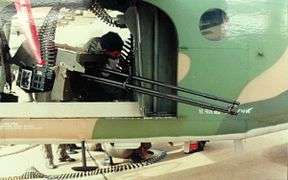 XM197 20mm rotary cannon on an AU-23 Peacemaker
XM197 20mm rotary cannon on an AU-23 Peacemaker
Renewed interest in the concept of gunships has resulted in the development of a gunship variant of the Alenia C-27J Spartan. Although the United States Air Force decided not to procure the AC-27J, other nations including Italy have chosen the aircraft for introduction.[14] Additionally, in 2013 the US Air Force Special Operations Command reportedly tested a gunship version of the C-145A Skytruck armed with a GAU-18 twin-mount .50-calibre machine gun system.[15]
Helicopter gunships
Early helicopter gunships also operated in the side-firing configuration, an early example being the Aérospatiale Alouette III. During the Overseas wars in Africa in the 1960s, the Portuguese Air Force experimented to install M3 Browning .50 caliber machine guns in a side-firing twin-mounting configuration in some of its Alouette III helicopters. Later, the .50 caliber machine guns were replaced by a MG 151 20mm cannon in a single mounting. These helicopters were known in Portuguese service as "helicanhões" (heli-cannons) and were used in the escort of unarmed transport helicopters in air assault operations and in the fire support to the troops in the ground. The South African and Rhodesian air forces later used armed Alouette III in similar configurations as the Portuguese, respectively in the South African Border and Rhodesian Bush wars.[16]
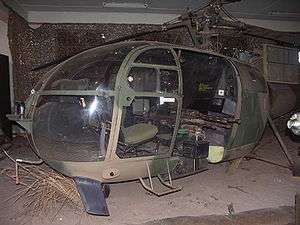
During the Algerian War, the French operated Sikorsky H-34 "Pirate" armed with a German 20mm MG151 cannon and two .50 machine guns. During the early days of the Vietnam War, USMC H-34s were among the first helicopter gunships in theater, fitted with the Temporary Kit-1 (TK-1), comprising two M60C machine guns and two 19-shot 2.75 inch rocket pods. The operations were met with mixed enthusiasm, and the armed H-34s, known as "Stingers" were quickly phased out. The TK-1 kit would form the basis of the TK-2 kit used later on the UH-1E helicopters of the USMC.
The U.S. Army also experimented with H-34 gunships armed M2 .50 caliber machine-guns and 2.75-inch rockets. In September 1971, a CH-34 was armed with two M2 .50 caliber machine guns, four M1919 .30 caliber machine guns, forty 2.75-inch rockets, two 5-inch high velocity aerial rockets (HV AR), plus two additional .30 caliber machine guns in the left side aft windows and one .50 caliber machine gun in the right side cargo door. The result was the world's most heavily armed helicopter at the time.
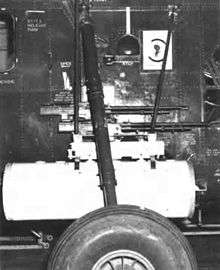 TK-1 Armament Subsystem on the UH-34D helicopter
TK-1 Armament Subsystem on the UH-34D helicopter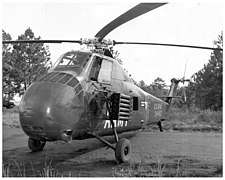 US Army Sikorsky S-58 gunship armed with two M2 .50 caliber machine-guns and twenty-four 2.75-inch rockets
US Army Sikorsky S-58 gunship armed with two M2 .50 caliber machine-guns and twenty-four 2.75-inch rockets
Also, during the Vietnam War, the ubiquitous Bell UH-1 Iroquois helicopters were modified into gunships by mounting the U.S. Helicopter Armament Subsystems—these were forward-firing weapons, such as machine guns, rockets, and autocannons, that began to appear in 1962–1963.[17] Rotary-wing aircraft (helicopters) can use a variety of combat maneuvers to approach a target. In their case, the term gunship is synonymous with heavily armed helicopter.[18] Specifically, dedicated attack helicopters such as the Bell AH-1 Cobra also fit this meaning.[18] In any case, the gunship armaments include machine guns, rockets, autocannons, missiles, etc.[18]
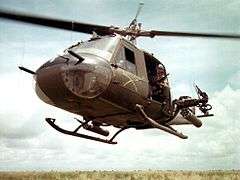 UH-1B helicopter gunship
UH-1B helicopter gunship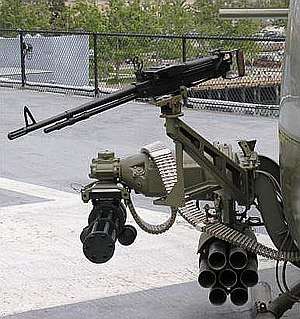 Typical armament for UH-1 helicopter gunship.
Typical armament for UH-1 helicopter gunship.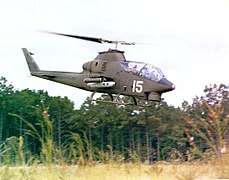 Bell AH-1 Cobra helicopter gunship
Bell AH-1 Cobra helicopter gunship
The Soviet Mil Mi-24 (NATO code name: Hind) is a large, heavily armed and armored helicopter gunship and troop transport.[19] It was introduced in the 1970s and operated by the pre-1991 Soviet Air Force and its successors post-1991, and more than 30 other nations.[20] Its armaments include machine guns, rockets, cannons, missiles, etc.[20] Its fuselage is heavily armored and is designed to withstand .50 caliber (12.7 mm) machine gun fire. Its armored cockpits and titanium rotor head are able to withstand 20 mm cannon hits.[20]
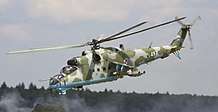
Examples
- Fixed wing
- Basler BT-67
- Douglas AC-47 Spooky
- Fairchild AC-119 Stinger
- Lockheed AC-130
- Alenia MC-27J Praetorian
- Fairchild AU-23 Peacemaker
- Helio AU-24 Stallion
- Airbus AC-235
- Airbus AC-295
- Helicopter
- Aérospatiale Alouette III variants
- SA 330 Puma in the "Pirate" variant (Pirate is the official nickname for helicopters with side-mount armament in the French Army[21])
- Boeing AH-6
- Boeing ACH-47 Chinook
- Bell OH-58 Kiowa variants
- Bell UH-1 Iroquois variants
- Mil Mi-24
- SikorskyMH-60L Direct Action Penetrator (DAP)
See also
References
Notes
- Ballard 1982, p. 9.
- Hamlin 1970.
- Associated Press (February 14, 2015), Mystery photo unseen for 30 years may show Civil War gunship, Fox News
- Buttler, Griffith American Secret Projects: Fighters, Bombers Attack Aircraft 1937 to 1945 p104-105
- Dorr 2011.
- Merriam 2000.
- North American B-25B Mitchell Factsheet.
- Skaarup 2012, p. 265.
- It can be seen in action here.
- "AC-47 Factsheet". Archived from the original on 2014-10-11.
- Ballard 1982, p. 84, quote: "... the Air Force decided to substitute Gunship II for the more nautical Gunboat designation".
- "The AC-119 Gunships". Archived from the original on 2007-01-26. Retrieved 2010-11-12.CS1 maint: ref=harv (link)
- "AC-130H Spectre, AC-130U Spooky". FAS.org.CS1 maint: ref=harv (link)
- "Italian Air Force To Launch Gunship C-27J".
- "The Air Force Tested a Mini-Gunship Last Year".
- Stringer 2006, p. 124.
- Dunstan 2003.
- Bishop 2006.
- Mil Mi-24 Hind Gunship. By Alexander Miladenov. Osprey Publishing 2010. Pages 4–10.
- OPFOR WORLDWIDE EQUIPMENT GUIDE
- Puma helicopters armed with 20mm canon in Central African Republic Les hélicoptères Puma armés de canon de 20 mm en Centrafrique (in French)
Sources
- Ballard, Jack S. (1982). "Development and Employment of Fixed-Wing Gunships, 1962–1972" (PDF). Air Force Historical Studies Office. p. 9. Retrieved 7 February 2011.CS1 maint: ref=harv (link)
- Bishop, Chris (2006). HueyCobra Gunships. pp. 3–5. ISBN 9781841769844.CS1 maint: ref=harv (link)
- Dorr, Robert F. (July 2, 2011). "Brilliant Mistakes: The YB-40". defensemedianetwork.com. Retrieved April 23, 2012.CS1 maint: ref=harv (link)
- Dunstan, Simon (2003-08-20). Vietnam Choppers (Revised Edition): Helicopters in Battle 1950–1975. pp. 25–27. ISBN 9781841767963.CS1 maint: ref=harv (link)
- Hamlin, Ross E. (1970). "Side-Firing Weapon Systems: A New Application of an Old Concept" (PDF). Air University Review. Retrieved 16 December 2016.CS1 maint: ref=harv (link)
- Merriam, Ray (2000). U. S. Warplanes of World War II. ISBN 9781576381670.CS1 maint: ref=harv (link)
- "NORTH AMERICAN B-25B MITCHELL factsheet". National Museum of the United States Air Force.
- Skaarup, Harold (2012). California Warplanes. p. 265. ISBN 978-1-4759-0144-3.CS1 maint: ref=harv (link)
- Stringer, Kevin D. (2006). Military Organizations for Homeland Defense and Smaller-Scale Contingencies. Praeger Publishers. p. 124. ISBN 0-275-99308-6.CS1 maint: ref=harv (link)